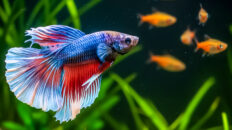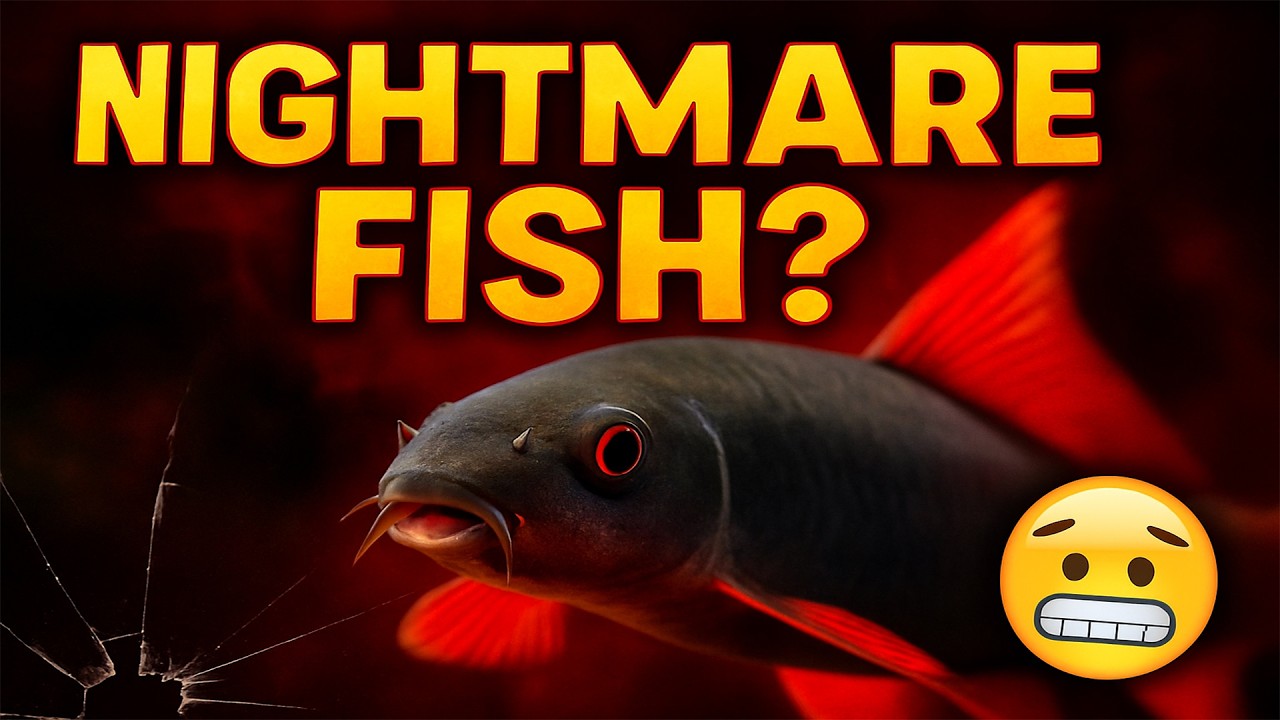It was around midnight — that dangerous hour when logic goes to sleep and your wallet takes control.
I was scrolling through a late-night aquarium forum when I saw it:
“RARE MONSTER FISH – LIMITED STOCK – SHIPS TONIGHT.”
My brain whispered, “You only live once.”
My common sense replied, “So do your fish.”
At twelve thirty-seven, the deal was done. I had just ordered six of the most dangerous, awe-inspiring, and downright ridiculous freshwater fish ever sold online.
This is the story of what arrived… what survived…
and what nearly destroyed my living room.
And if you’ve ever made an impulsive aquarium decision after midnight — welcome to the club.
The Midnight Click That Changed Everything
Every aquarist knows that late-night itch — scrolling listings, imagining how incredible a “monster tank” would look. What we don’t imagine is the cleanup afterward.
Behind every viral unboxing of a monster fish lies a lesson in biology, behavior, and pure chaos.
#6 – Arapaima gigas (The Amazon Titan)
The listing said “juvenile Arapaima.”
What came out looked like a muscle with fins.
At first, calm and majestic — by month two, it was eating a kilogram of shrimp a day and staring at me like I owed it rent.
Arapaimas are living fossils that breathe air through a modified swim bladder and can grow over 3 meters long.
In a 2024 report by the Amazon Conservation Institute, researchers found captive Arapaimas increase oxygen intake by 25% in still water — which explains why mine surfaced every 30 seconds like a mini submarine.
Their scales? Biological armor. A 2021 study in the Journal of Materials Science showed it takes a sharpened steel blade to cut through a single scale.
Beautiful, ancient, and completely inappropriate for a living room.
Moral: Some fish aren’t tankmates — they’re tenants.
#5 – Alligator Gar (The Armored Relic)
Every monster fish beginner falls for this one. You see that prehistoric snout and think, “He looks chill.” He’s not.
Alligator Gars have scales like bone and jaws strong enough to snap a net handle.
According to a 2023 University of Louisiana study, their bite pressure exceeds 300 newtons — roughly the force of a car door closing on your hand.
Mine didn’t bite me — but it did bite through my heater cable like candy.
Owning one felt less like fishkeeping and more like sharing a bathtub with a prehistoric reptile who refuses to pay rent.
#4 – Bichir (Polypterus endlicheri)
This was supposed to be my “safe” purchase.
The seller called it a gentle dinosaur fish — they weren’t wrong, but they forgot to mention the escape attempts.
In 2022, Kyoto University researchers observed juvenile Bichirs using their limb-like fins to walk across surfaces — a glimpse of evolution in motion.
Mine used that skill to climb out of the tank. Twice.
I found it under the couch, covered in dust, alive, and visibly offended.
Fascinating, hardy, prehistoric — but without a lid, there’s no peace.
#3 – Iridescent Shark (Pangasianodon hypophthalmus)
Online photos make them look peaceful — sleek, silver, elegant.
In reality? A jittery torpedo that panics if you sneeze too loud.
They’re not sharks but catfish from the Mekong River that can reach a meter in length.
A 2021 Thai Aquaculture study found their stress hormones spike 200% in tanks under 400 liters — explaining why mine ricocheted off the glass like a pinball every time the lights turned on.
They’re beautiful, but keeping one in a small tank feels like parking a race car in a closet.
#2 – Giant Snakehead (Channa micropeltes)
The apex predator. The reason half of Asia bans them in the aquarium trade.
I ordered one labeled “juvenile predator fish.” The package might as well have said “future lawsuit.”
Snakeheads breathe air, leap like missiles, and hunt anything that moves.
A 2023 Smithsonian Review of Invasive Species reported that adult Snakeheads can survive on land for up to four days and migrate between ponds.
Mine tried to jump during feeding — and nearly made it into the kitchen sink.
They’re smart, responsive, and terrifying.
Brilliant creatures — but one tantrum away from turning your tank into an action movie.
#1 – Giant Freshwater Stingray (Urogymnus polylepis)
This one didn’t even fit in frame.
Wingspan: nearly two meters when mature. Graceful, silent, and surprisingly affectionate — until feeding time.
Chulalongkorn University (2022) found that freshwater stingrays detect electric fields with 50× the sensitivity of most fish.
That’s why mine sensed me walking into the room and expected dinner instantly.
Watching it glide was like silk in motion.
Feeding and maintaining it? A full-time job.
Releasing it to a sanctuary was the proudest, humblest moment of my fishkeeping life.
Bonus – The Monster I Didn’t Buy
I almost clicked “Buy” on a Goliath Tigerfish — then I saw the teeth.
In 2025 conservation reports, scientists warned that wild populations of large river predators are collapsing due to illegal online exports.
That was my wake-up call.
Just because you can buy a monster doesn’t mean you should.
From Chaos to Mastery
If you’ve watched this far, you’re not just curious — you’re committed.
You’ve officially joined the FishTank Mastery crew — a community of aquarists who learn, laugh, and sometimes panic together.
Here, we don’t hide our mistakes — we study them.
Because every disaster tank is just a masterclass in disguise.
And as I learned the hard way, some fish aren’t mistakes — they’re teachers.
Next episode? Let’s just say it involves forbidden fish and one very angry customs officer.
Until then — keep your lids tight, your tanks balanced, and your curiosity flowing.
Scientific References & Further Reading
The science behind these monster fish stories isn’t just anecdotal — it’s backed by decades of aquatic research.
For instance, the Amazon Conservation Institute (2024) published groundbreaking data on oxygen intake adaptation in captive Arapaima gigas, explaining why these massive air-breathing predators surface so frequently in still-water aquariums.
Their findings revealed that Arapaimas increase oxygen uptake by nearly 25% under low-oxygen conditions, a key factor in understanding their restlessness in home tanks.
The Journal of Materials Science (2021) examined the microstructure and toughness of Arapaima gigas scales, confirming their layered bone-plate composition.
This biological armor allows the Arapaima to resist both predators and sharp objects, making it one of the most physically resilient predatory freshwater fish on Earth.
The research also highlighted how this natural material could inspire future bioengineering designs — a fascinating blend of nature and technology.
Meanwhile, the University of Louisiana (2023) studied the bite mechanics of Lepisosteus species such as the Alligator Gar.
Their experiments measured bite pressure exceeding 300 newtons, helping explain why Gars are capable of breaking heater tubes, nets, and even silicone seams.
In comparison, the Kyoto University (2022) team investigated terrestrial locomotion in Polypterus species — also known as Bichirs — documenting how these “walking fish” use fin-driven propulsion to traverse land, often escaping aquariums when stressed or under-oxygenated.
On the behavioral side, the Thai Aquaculture Research Institute (2021) explored stress responses of Pangasianodon hypophthalmus (Iridescent Sharks) in confined aquaria.
Their findings showed a 200% spike in cortisol levels in tanks under 400 liters, supporting the theory that fish stress in captivity directly triggers erratic swimming and glass collisions.
Similarly, the Smithsonian Review of Invasive Species (2023) documented land migration behavior in Channa micropeltes (Giant Snakehead), a species capable of surviving four days out of water — solidifying its reputation as one of the world’s most invasive predatory aquarium fish.
Finally, Chulalongkorn University (2022) conducted advanced sensory mapping on Urogymnus polylepis (Giant Freshwater Stingray).
They discovered that stingrays can detect electrical fields with 50 times the precision of most freshwater species, explaining their uncanny ability to recognize keepers during feeding.
This study adds a new dimension to understanding freshwater stingray intelligence and emotional responsiveness — proof that these gentle giants are far more perceptive than most aquarists realize.
Together, these studies paint a vivid, science-backed picture of how biological design, environmental stress, and evolution intersect within the monster fish aquarium world.
They remind us that each of these species — from Arapaima to Stingray — is more than a visual marvel; it’s a living legacy of natural engineering and adaptation that demands respect and responsibility.
Explore More Monster Fish Stories & Guides
Still fascinated by how easily one late-night click can unleash an aquatic disaster? You’re not alone.
If this story made you think twice before ordering that next “rare predator,” you’ll want to dive into our related guides.
Each one uncovers another layer of the monster fish world — from banned species and aggressive tankmates to safe beginner setups that actually work.
For starters, check out Don’t Buy the Deadliest Monster Fish off the Web ⚠️ — a breakdown of real-life cases where hobbyists accidentally bought apex predators online.
You’ll see how easily excitement can turn into chaos, and how some species, like Snakeheads and Wolf Cichlids, are illegal for good reason.
Then follow it up with 11 Monster Fish That DESTROY Tanks (Viewer Picks), which features community-submitted disasters that prove even “peaceful” fish can become territorial terrors.
If you’re still wondering which species can safely coexist, Top 10 Most Aggressive Aquarium Fish dives into the behavioral science behind aggression —
why certain fish lash out, how tank size triggers dominance, and what subtle stress cues most keepers miss until it’s too late.
It’s a must-read if you’ve ever asked, “Why do my community fish keep fighting?”
And for those who want to reset their tank and start fresh after a “monster meltdown,”
Your First Fish Tank? 10 Beginner Aquarium Fish You Won’t Regret Buying is the perfect recovery guide.
It walks you through peaceful stocking plans, low-maintenance species, and the science of compatibility —
a calm after the storm for anyone ready to rebuild smarter.
Whether you’re into predatory aquarium setups or peaceful community aquascapes, these interconnected stories complete the journey from chaos to clarity.
Because here at FishTank Mastery, every mistake becomes a lesson — and every lesson gets you one step closer to true mastery.

Frequently Asked Questions (FAQ)
Every aquarist who’s ever hovered over that “Buy Now” button at midnight has a few questions afterward. Below, we’ve gathered some of the most common queries about monster fish care, legality, and aquarium setup — straight from experience and backed by science.
Is it safe to buy monster fish online?
Not usually. Many predatory aquarium fish like Arapaima gigas or Channa micropeltes (Giant Snakehead) outgrow home aquariums and require enormous tanks exceeding 3,000 liters. Always research adult size, temperament, and regional legality before buying. A moment of curiosity online can quickly turn into a long-term responsibility.
Why do monster fish become aggressive in captivity?
Aggression in large freshwater species is rarely about temperament — it’s about stress, confinement, and environmental imbalance. Studies from aquatic behavior institutes have shown cortisol spikes in territorial fish when kept in small, unstructured tanks. Ensuring proper space, hiding zones, and water flow can dramatically reduce violent behavior.
Can Arapaima or Alligator Gar live in home aquariums?
Technically yes, but only in public aquarium-grade systems. Both species are oxygen-breathing giants that reach over two meters in length and require filtered, open-top environments. Without that, they can injure themselves or even break equipment. Most aquarists eventually rehome them to sanctuaries once growth outpaces tank capacity.
Why are Snakeheads illegal in some countries?
The Giant Snakehead (Channa micropeltes) is a fascinating yet invasive predator. According to the Smithsonian Review of Invasive Species (2023), Snakeheads can survive out of water for several days, migrate between ponds, and devastate local ecosystems. That’s why they’re banned under the U.S. Lacey Act and restricted across parts of Europe and Asia.
Do Iridescent Sharks really stress easily?
Absolutely. Despite the name, Iridescent Sharks are catfish that thrive in open rivers — not glass boxes. A study by the Thai Aquaculture Research Institute (2021) revealed a 200% cortisol increase in confined aquaria under 400 liters. Keeping them calm means maintaining space, stable lighting, and low-reflection tank glass.
Are Freshwater Stingrays dangerous?
Only if mishandled. Urogymnus polylepis (Giant Freshwater Stingray) is incredibly intelligent and sensitive to water parameters. They detect electrical fields 50 times more precisely than most freshwater species (Chulalongkorn University, 2022). Their barbs are defensive, not offensive — treat them with respect, and they’re gentle giants.
What should beginners do instead of buying predatory fish?
Start with community-safe species and learn water chemistry, cycling, and tank balance before upgrading. Consider planted setups with species like Corydoras, Tetras, or Rasboras to build confidence. A well-balanced ecosystem will always teach more than chaos ever could.
How do I know if a fish species is too large for my tank?
Check both adult size and behavior profile. Many fish sold as “juveniles” quickly grow to several feet within months. Before buying, search for scientific names (like Pangasianodon hypophthalmus or Lepisosteus osseus) and cross-reference them on FishBase or regional wildlife databases.
Why is Arapaima considered a ‘living fossil’?
Because it’s one of the few fish that still uses a primitive air-breathing system through a modified swim bladder. Research by the Amazon Conservation Institute (2024) revealed that captive Arapaima gigas can increase oxygen intake by nearly 25% in still-water tanks — proof of evolutionary brilliance.
Can I mix monster fish with community species?
Only if you want a natural selection experiment in your living room. Mixing predators with peaceful fish is never sustainable. Instead, dedicate separate tanks for large carnivores and small community setups — it’s better for your fish, your filter, and your sanity.
Monster fish are breathtaking, ancient, and powerful — but they’re also reminders that some species are meant to be admired, not owned.
Before adding one to your cart, make sure your aquarium — and your patience — are big enough to handle what’s coming.










Add comment